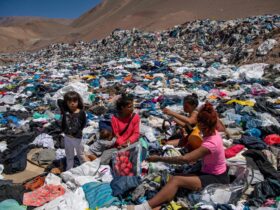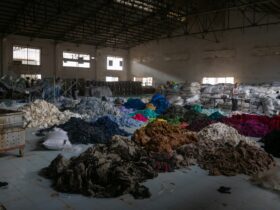By: Lauren Schulsohn
Photos by: Lauren Schulsohn and Jacob Wisnik
Just a little over 150 miles from the heart of downtown Los Angeles lies the Salton Sea, once a bustling vacation destination for Hollywood stars and affluent beach goers in the 1950s, is now a toxic, primarily abandoned, eerily beautiful, reminiscent place of what once was. Finance Chair Jacob Wisnik, Governor Cameron Mellilo and myself, President Lauren Schulsohn made the four hour trek — thank you Southern California traffic — to explore this unique destination.

South of Palm Springs, and, in the midst of the Southern California desert, is the Salton Sea. The current body of water that comprises the Salton Sea is not a naturally formed lake. Rather, following the flooding of a canal being constructed on the Colorado River, in 1905, the excess water created the Salton Sea. It is not necessarily rare to see a large body of water in this area as Lake Cahuilla existed for approximately 2,000 years and then disappeared after 1580. However, what is of concern, is that as the Salton Sea was accidently man-made, there is no fresh-water flowing into the lake.
As the lake has no fresh water flowing into its body, it has consistently struggled to sustain its size. In an effort to preserve the size of the lake and to efficiently discard agricultural waste, as the Salton Sea sits in Imperial County, home to approximately 500,000 farmable acres, farmers began funneling their agricultural run-off into the lake. And for years, this strategy worked, and allowed for the construction of resorts, yacht-clubs, restaurants, and a bustling beach town with the occasional visit from the Beach Boys and Frank Sinatra. The lake even served as a WWII Naval Auxiliary Air Station that tested dummy atomic bombs to better understand aerodynamics. However, as the 1970s came along, without a fresh-water source, the lake struggled with rising salinity, toxic pesticides, and flooding that came from excessive dumping of agricultural runoff, leaving resorts destroyed and optimism low – people got up and left. Today, the Salton Sea is virtually a ghost town.

In the last 25 years, the Salton Sea has lost a third of its water, and due to decreased rainfall and rapid climate change, it is projected that California’s largest body of water will lose 75% of its current volume by 2030. The remaining fresh water sources that did flow into the lake were cut-off in 2003 and re-routed to San Diego county. In the face of drought, California believed that the fresh-water would have more use in San Diego county as over 3 more million people inhabit the area.
The degradation of the Salton Sea has had significant implications on the environment and human-life. In the summer of 1999, the Los Angeles Times reported that on average 7.6 million fish die every day. Today, there are barely any fish in the lake left that can stand the high-levels of salinity. The ones that can, such as the Mozambique tilapia, western mosquitofish, and the native desert pupfish, reside on the few toxic waterways that flow into the lake. These waterways are also already extremely polluted by the time they reach the Salton Sea. While there used to be swaths of dead fish piled high each year as a result of the toxicity, today, these piles do not even occur as there are nearly no fish left. Instead, one can see the reminiscence of the piled high dead fish as crushed fish bones primarily make up the sand on Salton Sea beaches and dead fish residing on the bottom of the lake create a distinct smell that is unmissable.

After exploring the ruins of Bombay Beach, our team drove out to Sonny Bono Salton Sea National Wildlife Refuge to examine the bird populations. Over 400 different bird species reside in this area allowing the population of birds to be over 100,000, with even more in winter months. While that estimate does seem like a lot, it is only half or even a third of what used to live on the Salton Sea just a decade ago. White pelicans, a popular icon of the Sea, have become a nearly impossible site. Without abundant fish populations, birds find other places to spend their time; however, non-fish eating birds will most likely always continue to find their way to the Salton Sea.

The human and economic toll on this area has been vast. The air surrounding the sea has become increasingly toxic with a high concentration of aerosolized particulates. As a result, the air is causing respiratory illness and higher levels of childhood asthma. Due to the toxicity of the lake and the consistent shrinkage, it is difficult to set up businesses as people cannot rely on the lake for entrepreneurship. No one uses the lake for fishing and there is not a single company that you can rent a boat to ride on the lake. It is projected that the Salton Sea will cost Greater Palm Springs billions in lost tourist revenue in the next five years.
Imperial County, populated by 180,000 people, is 80.9% Latino, 13.7% White and 10.5% African-American, has higher levels of poverty, with 23% of the population living below the poverty line, which is 8% higher than the California average.
Being less than 40 miles from the U.S.-Mexico border on the lake’s most southern tip, our team had to go through two border checkpoints on our drive around the sea. Routinely, drugs, including fentanyl, heroin, and methamphetamine, are found at these checkpoints, often with quantities over $100,000.

One source of sustainable economic growth has been the geothermal energy facilities that first began operation in 1982. As the Salton Sea lies on the San Andreas fault line, these facilities work to harvest the energy from hot fluid. Following the gathering of energy from this hot fluid, they infuse the now cooled fluid back into the ground. There are 11 facilities around the Salton Sea conducting this work.
In recent years, it has been discovered that enormous deposits of lithium reside underneath the Salton Sea and its surrounding areas. Experts believe that there is enough lithium in this area to provide batteries for over 50 million electric vehicles over a three year period. Instead of these facilities putting the cooled fluid back into the ground immediately, they would first extract the fluid for lithium before inserting it back into the ground. In a political landscape that is putting greater emphasis on electric machinery and automation, once the technology for this type of lithium mining is fully developed, operations will most likely begin.

While there are some prospects for economic revitalization via lithium mining, after speaking with locals, the sentiment was all the same; even if they cannot swim in the lake, they don’t want to see it gone. Doing nothing to mitigate decreasing water levels also is not even a safe solution as the air is becoming increasingly toxic and endangered species are suffering great losses.
Over the years, many research studies and calls for action have taken place, and despite this work, real change has not come. Some recommendations have called for providing an influx of fresh water to the Salton Sea; however, this project would cost billions of dollars and only impact a small population of California. In November, the federal government pledged $250 million to restore the Salton Sea as part of the Inflation Reduction Act, and in December, the U.S. Army Corps of Engineers began a contract to find short and long term solutions to help preserve the Salton Sea.

Although the solution to restoring the Salton Sea is unclear, just like any place facing environmental degradation, life continues to live on in the area, and in many ways, flourish. The Salton Sea area has an influx of people moving in, beautiful structures of art are constantly being created, and on our adventure, we saw other tourists marveling at the majestic bird population. In our journalistic pursuit to assess severe environmental effects, we also found ourselves enjoying Cabernet Sauvignon with the locals at America’s only lawless city known as Slab City, drinking date milkshakes in Westmorland, and cleaning off our muddy shoes after a genuinely fun day at the Salton Sea.
Despite our fun, the Salton Sea is not just a ghost town trying to find its identity in a society that has left it behind. We must use the Salton Sea as a lesson of inaction that can be applied across the world. Yes, life lives on, but every time there is an environmental threat or disaster, we cannot wait to see what happens. We must act. And our stop of inaction and start of action should begin right in our own backyard, with the restoration of the Salton Sea.






